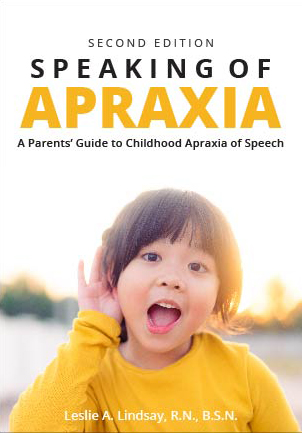This advice-column-style blog for SLPs was authored by Pam Marshalla from 2006 to 2015, the archives of which can be explored here. Use the extensive keywords list found in the right-hand column (on mobile: at the bottom of the page) to browse specific topics, or use the search feature to locate specific words or phrases throughout the entire blog.
Older Child With Apraxia and Dysarthria
By Pam Marshalla
Q: I am a speech-language pathologist at a children’s hospital. I have a boy that I see for therapy who is severely (whole body) apraxic. He has been coming to therapy for years at this hospital and has been through multiple therapists. He is intelligible and we are currently working on /l/ and /l/-blends. He substitutes n/l. I feel like he has reached a plateau.
He also receives therapy in school. He has most sounds except vowels, diphthongs, some blends, and all voiced consonants. These areas have been targeted in the past with progress made and a plateau reached as well. Any ideas? I’m lost and his mother does not want to give up therapy at this hospital.
 If his vowels and diphthongs are distorted, he has nasality problems, and he has difficulty controlling voice onset, this sounds like dysarthria. He is probably a kid who is both apraxic and dysarthric.
If his vowels and diphthongs are distorted, he has nasality problems, and he has difficulty controlling voice onset, this sounds like dysarthria. He is probably a kid who is both apraxic and dysarthric.
The apraxia shows up more in the early years as a LACK of sound. But as phonemes are gained, the continued distortion of vowel sounds is the dysarthria. If it is dysarthria, there should be rate and rhythm problems too. The nasal substitutions are more a dysarthric problem as well.
The problem most of us have is that we think in terms of learning consonants. This is not where the problem is with dysarthria. The problems that interfere with clear speech in dysarthria are rate, rhythm, prosody, resonance, voicing onset and distortion of sound.
Focus on Prosodic Elements
Rate, rhythm, projection of voice, loudness, intonation, voicing and “punching out” syllables. Make him speak up, speak out, perhaps speak a little louder.
Focus on Resonance
Oral vs. nasal sound. Help him learn to remain oral at all times except for /m, n/, ng/. Teach him to remain oral while producing all the glides. Help him tune his ear towards oral resonance. To him it feels and sounds normal to be overly nasal. Help him learn to hear than and to force a more oral sound.
Focus on Vowels
Clarity on individual vowels. Begin with the earliest developing vowels – ee, oo, ah, oh, uh. Work on the vowels in isolation. Prolong them together so he has time to hear the acoustic parameters of each. Work on saying single-syllable words with clear vowels. Start with CV words: go, see, no, me, do, bee, etc.
Focus on Diphthongs
Make sure he is producing clear single vowels on each end of the diphthong. Work on CVV words: hi, bye, you, now, etc.
Focus on Rhythm
Through syllable maintenance: work on punching out the correct number of syllables in words.
Focus on Voicing
Teach him to turn his voice “on” and “off” at will. Teach him to control the transition between turning his voice on and off in a sequential speech act. I like to have kids practice sequences like:
- Ah—H—Ah—H—Ah…
- Sss—zzz—sss—zzz—sss…
- Shhh—zhhh—-shhh—zhhh…
This way they learn to turn the voice on and off at will without having to change oral movement too. Then move on to single syllable words like “so” during which they have to be voiceless on the “s” and then turn voice on as they transition to the vowel. Have the child prolong the “s” and slowly transition into the vowel so he can hear and control the voice onset.
Focus on Clusters
Focus on Clusters by making two syllables out of them, For example, pronounce “blue” as “buh—lue. ” Pronounce “brown” as “buh—rown.” Teach him to give himself more time to produce each element of the cluster.
The topic of dysarthria has gone out of favor in recent years as the topic of apraxia has taken over. But long term kids like the one you have described are dysarthric. The dysarthria takes longer to resolve when we ignore these underlying issues.

This was a very useful information ! Thank You ! K. Baker , SLP